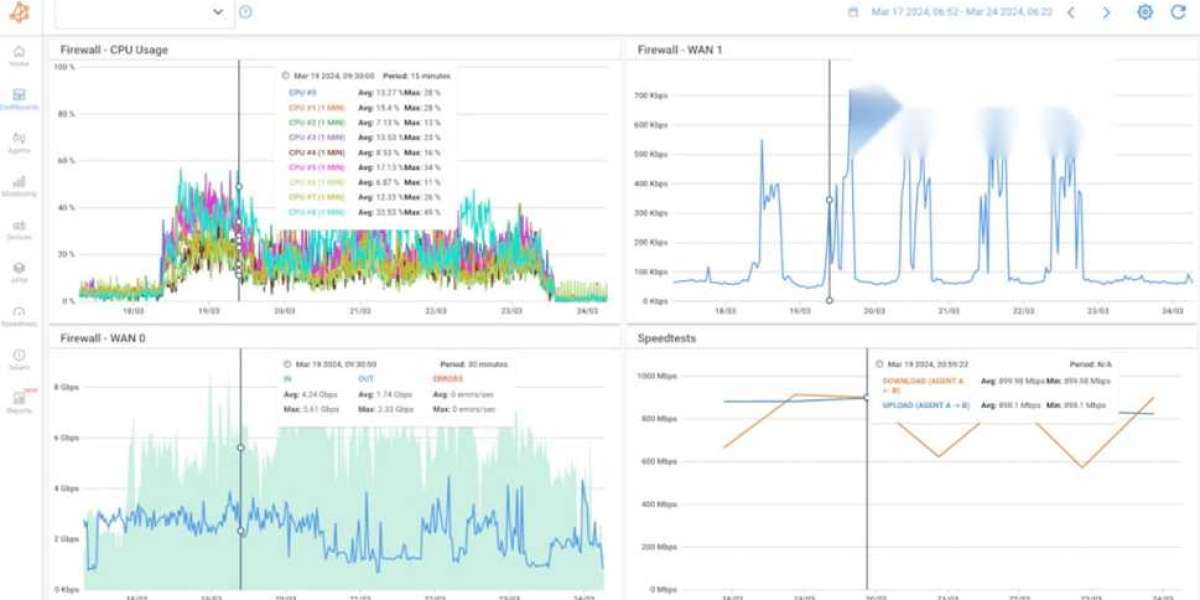Top Tools for Measuring Latency
In the realm of corporate networking, maintaining swift delivery speeds is crucial.
It's essential to not only monitor response times but also assess the adequacy of network speeds across all pathways utilized by user communications.
Here’s an overview of top tools for measuring network latency:
1. Obkio
This monitoring solution excels in device status tracking and traffic analysis, helping to identify issues like latency, jitter, and packet loss. A 14-day free trial is available.
2. Site24x7
Offering a comprehensive monitoring system, this tool includes a bandwidth analyzer that gathers live traffic data from routers and switches to identify bottlenecks. Try the 30-day free trial.
3. ManageEngine OpManager
This system features a latency testing tool ideal for monitoring VoIP traffic and WAN connections. It can be installed on Windows Server, Linux, or accessed via AWS, with a 30-day free trial option.
4. Network Pinger
A ping sweep and traceroute tool for Windows that provides graphical representations of network performance.
5. Paessler PRTG
Utilizing network latency sensors, this monitor tracks round-trip times, packet sequences, losses, and jitter.
6. SolarWinds Network Performance Monitor
A robust monitoring system designed for Windows Server environments.
7. ManageEngine Free Ping Tool
A straightforward ping utility compatible with both Windows and Linux.
8. PingPlotter
This tool offers recursive ping capabilities along with graphical output for easier analysis.
9. Nirsoft NetworkLatencyView
A free tool for Windows that employs ping tests to evaluate network performance.
10. Angry IP Scanner
A free ping sweep tool that works across Windows, Linux, and macOS platforms.
11. Pinkie
Another free Windows tool designed for conducting ping sweeps.
12. Netscan Tools
This tool focuses on ping-based performance assessments for Windows networks.
Conducting manual tests for every network path can be time-consuming.
Investing in a reliable testing tool is essential to prevent latency from hindering your network's efficiency.
When searching for latency testing solutions, consider tools that integrate into broader utility packages, or opt for simple tools that enhance basic ping functionalities. Latency refers to the responsiveness of your network traffic.
It's important to note that latency cannot simply be categorized as 'good' or 'bad'.
The acceptable levels of latency depend on the specific application involved.
For instance, activities such as video streaming or real-time VoIP conversations require quicker response times compared to sending emails.
Therefore, it's crucial to assess and determine the necessary speeds for your network based on the services you offer to your users.
Latency is typically measured in milliseconds (ms), and there are two primary metrics used to assess it. When conducting network tests, it’s crucial to maintain consistency by sticking to one measurement type throughout your records.
The most widely recognized latency metric is “round trip time” (RTT), which indicates the duration it takes for a packet to travel to a destination and back. Alternatively, “time to first byte” (TTFB) measures the interval from when the initial part of a packet departs until it reaches its destination. RTT is more commonly utilized than TTFB since it can be executed from a single location without the need for special software on the remote device.
For network latency testing, every computer connected to a network comes equipped with a built-in tool known as ping. This utility operates on the Internet Control Message Protocol (ICMP) at the internet layer. Ping is a staple among network administrators, providing a quick way to perform latency checks without requiring additional software on the target machine.
When you run a ping command, it typically sends 32 bytes of data to the specified destination and logs the time taken for a response to return. The total latency is reported as the round trip time, which encompasses the travel time of both the sent and received packets, displayed in milliseconds.
If you are testing RTT for a website, you don’t need the actual IP address; ping can accept the domain name directly. By default, ping sends four packets, but you can easily adjust this number using command options.
The output from the ping command provides detailed RTT results for each packet sent, along with a summary. You’ll see how many packets were dispatched, how many responses were received, and any packet loss that occurred. The report also includes the percentage of lost packets relative to the total sent. Additionally, it summarizes the minimum, maximum, and average round trip times for the entire set of tests conducted.When dealing with network performance issues, a common starting point is the use of the ping command. While it's useful for identifying slow paths, it falls short in addressing latency issues directly and can't test multiple routes simultaneously. Thankfully, there are advanced tools built upon the ping concept that allow for a more comprehensive analysis.
These tools enable users to monitor several network paths from a single interface, and many can conduct continuous ping tests, providing real-time updates on latency performance.
Network latency can be a complex challenge, but it can be effectively managed using techniques like traffic shaping, which employs queuing algorithms. By implementing Quality of Service (QoS) strategies, you can prioritize critical data, ensuring that essential applications, such as live video streaming and VoIP, maintain their performance even in congested conditions.
However, prioritizing certain types of traffic can lead to delays in other areas, such as email transfers. A slight delay in non-urgent communications may be a small price to pay to prevent the need for costly network upgrades to accommodate all traffic types at peak speeds.
There are many excellent tools available for testing network latency, and many also offer insights into other important network metrics. One critical metric is jitter, which quantifies the variability in packet arrival times. High jitter can lead to significant issues for services that rely on consistent data flow, like video conferencing and IP-based telephony.
Another important factor to monitor is the available bandwidth across different segments of your network. Keeping an eye on potential capacity, median usage, and peak utilization will help you anticipate future needs, especially when new software or additional employee endpoints are being considered.
In our exploration of latency testing tools, we evaluated various options based on several key criteria:
- Capability to measure delay and jitter
- Availability monitoring features
- Traffic analysis capabilities
- Flexibility for on-demand or scheduled latency assessments
- Alert systems for unacceptable latency levels
- Free trials of paid tools for preliminary evaluation
- Value for money in paid tools or high-quality free tools
With these factors in mind, we've compiled a selection of outstanding latency testing solutions, ensuring a mix of both free and premium tools for diverse user needs.
Obkio serves as a robust tool for network oversight, offering immediate visibility into performance metrics across diverse environments.
It effectively tracks essential parameters such as latency , packet loss, and jitter, enabling IT teams to swiftly pinpoint and resolve network challenges. Through its network of distributed agents, Obkio continuously observes traffic flow among various locations, devices, and services, while also monitoring the operational status of network devices.
Notable Features:
-
Latency Monitoring : Keeps a close watch on latency levels throughout network pathways, ensuring peak performance.
-
Jitter and Packet Loss Tracking : Identifies key performance metrics that could lead to issues in real-time applications like video conferencing and VoIP.
-
Distributed Agent Deployment : Employs monitoring agents in both cloud and on-premise setups for thorough, end-to-end network surveillance.
-
Visual Data Representation : Offers insightful activity graphs for better data interpretation in the system console.
-
Monitoring Across Systems : Capable of analyzing activity in both virtual environments like VMware and Hyper-V as well as on physical endpoints.
We advocate for Obkio due to its comprehensive, real-time monitoring capabilities, especially its superior latency detection feature. The tool is straightforward to set up, supports distributed monitoring across various platforms, and boasts an intuitive user interface. Its proactive alerting mechanism allows IT teams to swiftly tackle network problems, thus averting major performance declines.
Obkio employs an array of strategies for its latency detection, including ping and traceroute methods. This functionality can be utilized throughout a network or across internet links. The system's flexibility is evident as it conducts tests between two agents, with the monitoring links dictated by the administrator’s choice of data collection agent placement.
For businesses that utilize cloud services or engage in real-time communications like VoIP and video conferencing, Obkio stands out as an excellent choice, particularly for small to medium-sized enterprises.
Its user-friendly interface is tailored for IT teams seeking a proactive monitoring solution that instantly identifies and resolves network issues. Organizations with multiple sites or remote offices gain significant advantages from its multi-location traffic monitoring capabilities.
Key Features Include:
-
Instant Notifications : Custom alerts are sent when network performance thresholds are exceeded.
-
Long-term Performance Analysis : Historical reports offer insights into trends, assisting in proactive management.
-
Device Monitoring : Employs SNMP for comprehensive network device surveillance.
-
Cloud-based Solution : As a SaaS offering, installation and operation are streamlined, with data securely stored in the cloud.
-
Educational Discounts : Special pricing is available for schools, colleges, and universities.
-
Focused Monitoring : While it excels at monitoring, it lacks extensive network management features such as configuration and security controls.
Obkio also provides a 14-day free trial .
Recognized as a leading tool for network latency testing, Obkio delivers precise, real-time performance insights that empower businesses to swiftly address latency issues that could hinder operations. Latency, the delay in data transmission, can adversely affect user experience and overall productivity.
With its robust monitoring features, Obkio is designed for effective latency problem detection and resolution. One standout capability is its continuous latency monitoring across various endpoints, including branch offices and cloud environments.
By deploying lightweight agents on each device, Obkio tracks latency in real time, enabling teams to quickly identify performance issues as they occur. This proactive approach helps in detecting latency spikes, identifying their origins, and preventing disruptions before they impact users.
Additionally, Obkio provides detailed reports and visualizations that facilitate latency data analysis, allowing teams to spot patterns and uncover potential issues such as network congestion or hardware failures. Custom alerts based on latency metrics ensure IT teams are notified when performance dips below acceptable standards.
Obkio's pricing structure is flexible, based on the number of devices, with options for various service levels, plus discounts for individual users and educational institutions.
Download now to access your 14-day free trial .When evaluating network performance, one crucial aspect to consider is latency.
To ensure optimal network functionality, several tools can assist in measuring and diagnosing latency issues effectively.
Here’s a guide to some of the top tools available for latency testing:
-
Ping : A fundamental utility that sends packets to a target host and measures the time it takes to receive a response. It’s simple yet effective for quick checks.
-
Traceroute : This tool tracks the route packets take to reach their destination, providing insight into where delays may occur along the path.
-
Wireshark : A powerful packet analyzer that captures and displays data packets in real-time, allowing for detailed analysis of network latency and traffic conditions.
-
NetSpot : This application assists in visualizing Wi-Fi performance, helping to identify latency issues caused by wireless interference or weak signals.
-
Obkio : A cloud-based monitoring solution that continuously tests network performance and provides insights into latency trends over time.
Each of these tools offers unique features that can help diagnose and troubleshoot latency problems effectively.
When selecting a tool, it’s essential to consider the specific requirements of your network and the type of analysis needed.
By utilizing these tools, network administrators can proactively address latency issues, leading to improved performance and user experience.
Regular latency testing is key to maintaining a healthy network environment.
Site24x7 offers a comprehensive cloud-based solution for system monitoring, which includes a robust network monitoring tool. This tool is seamlessly integrated across all subscription plans, which include:
- Website Monitoring
- Site24x7 Infrastructure
- Application Performance Monitoring
- All-in-One Plan
- Managed Service Provider (MSP)
The network monitoring tool comprises two main components: an SNMP-based device performance monitor and a bandwidth analyzer. The bandwidth analyzer's traffic analysis functionality interacts with network devices to gather essential traffic data. It supports various protocols, such as:
- NetFlow
- jFlow
- sFlow
- cFlow
- IPFIX
- NetStream
- AppFlow
This traffic analyzer is capable of showcasing traffic flow volumes per network link, as well as providing detailed statistics categorized by application, source, and destination. It highlights the top traffic generators in each segment. Users can view this data live via the dashboard, and it can also be archived for historical analysis, assisting in capacity planning efforts.
Notable features include:
- Cloud-based Accessibility: Ensures flexibility and ease of monitoring from anywhere.
- Comprehensive Traffic Analysis: Delivers in-depth insights into network traffic trends.
- Real-time Data Visualization: Generates dynamic charts and network maps for immediate analysis.
Site24x7 offers a cloud-based SaaS solution designed for comprehensive network monitoring, which encompasses both the monitoring of network devices and traffic analysis.
This tool provides real-time visualizations of traffic patterns, allowing users to identify issues through throughput graphs and conduct Quality of Service (QoS) testing on specific links. The result is a detailed latency report, along with various traffic condition metrics.
Users can examine traffic levels via time-series graphs, making it simple to spot traffic volume peaks over time. By switching data sources, one can assess traffic flow by application or source, which aids in pinpointing the origin of the traffic. Technicians can then apply QoS measures to manage overloaded devices effectively.
The monitoring service features performance thresholds that trigger alerts when exceeded. These alerts are visible on the system dashboard and can also be sent to technicians via SMS, email, voice calls, or instant messages.
Site24x7 provides a suite of monitoring modules for various IT systems, including network devices, software, and endpoints, available in bundled packages. This allows customers to access a complete range of services rather than just network monitoring. Subscription plans are tiered to accommodate the needs of both small and larger businesses, with pricing reflecting the capacity required.
-
Thorough Monitoring : Efficiently tracks latency, bandwidth, and infrastructure challenges.
-
Intuitive Interface : Recognized as one of the most user-friendly network monitoring tools on the market.
-
Flexible User Monitoring : Effectively connects technical metrics with business insights.
-
Learning Curve : Requires time to fully grasp its extensive features and options.
Site24x7 operates on a subscription basis, with no setup fees or deposits required. There are no contractual obligations or minimum service periods, and users can take advantage of a 30-day free trial for any of the available plans.
Start your 30-day free trial with Site24x7 network monitoring today.
Network Monitoring Tools Overview
ManageEngine OpManager offers a comprehensive suite for monitoring both networks and servers, featuring a built-in network latency testing tool .
This tool operates by utilizing ping tests, allowing for consistent evaluations of connectivity to specific devices or across the internet, effectively assessing communication between different locations in a Wide Area Network (WAN).
For companies heavily reliant on VoIP , this system is crucial. When networks become congested, it's possible to enhance VoIP performance by prioritizing voice traffic over other data. However, if your telephony system depends on the same network, simply rearranging traffic priorities may not suffice; you may need to invest in additional capacity to maintain optimal performance.
Highlighted Features:
-
WAN Latency Testing : Perfect for keeping tabs on the connections between various sites.
-
VoIP QoS Tool : Evaluates the quality of VoIP calls, including latency measurements across different links.
-
Mean Opinion Score (MOS) : Offers a reliable standard for measuring the quality of voice calls.
ManageEngine OpManager is an effective tool for monitoring networks and servers. It functions primarily as a network device monitor, comparable to the SolarWinds Network Performance Monitor. For more intricate traffic analysis, the ManageEngine NetFlow Analyzer is available. OpManager also features a WAN latency tester and a VoIP Quality of Service (QoS) testing tool that measures latency for each link.
The complete ManageEngine OpManager solution offers a variety of additional capabilities, such as autodiscovery, device monitoring, inventory management, and network topology visualization. This software is compatible with both Windows Server and Linux operating systems. If you're an AWS user, you can access OpManager through the AWS Marketplace to deploy it on their cloud platform.
For small businesses, ManageEngine provides a professional edition with a base price designed for monitoring up to 10 devices. Larger enterprises will incur higher costs as they scale to monitor more extensive networks. There is also a specific edition tailored for WAN monitoring, along with a free version that supports only three devices.
Key features include:
-
Jitter and Packet Loss Analysis : Offers in-depth reports on network performance.
-
Extensive Testing Capabilities : Addresses both network and inter-site latency challenges.
-
Historical Performance Tracking : Supplies important historical data beneficial for network assessment.
-
AWS Version Constraints : The AWS version does not include the complete flexibility of the SaaS package.
You can try the on-premises version with a 30-day free trial.
Start your 30-day free trial of ManageEngine OpManager today!
For further reading: check out how to resolve packet loss issues.
Network Pinger is a free utility designed for Windows users.
This user-friendly tool features an appealing interface primarily focused on displaying results from your network sweeps.
It performs recursive pings, testing every IP address within a range you specify, and showcases the output through various visual elements.
The side panels include a pie chart representing contact statuses and a line graph illustrating response times, along with the round trip time (RTT) for each connection attempt.
Highlighted Features:
-
Recursive Ping: Tests multiple IP addresses effectively within a defined range.
-
Graphical Insights: Provides visual representations of ping outcomes for better understanding.
-
Integrated Tools: Comes with traceroute, remote desktop, and additional network utilities.
Network Pinger is widely recognized for its fundamental role in latency measurement through the ping function.
It offers valuable features that are often associated with paid software, including detailed graphs of ping results and a built-in traceroute utility.
This versatile free tool also incorporates several other useful functionalities.
In addition to pinging, Network Pinger includes a traceroute feature that reveals response times for each hop along the route to a specified destination.
Moreover, it possesses a switch port mapper and allows users to connect to remote machines using built-in remote desktop, SSH, Telnet, and Rlogin capabilities.
For network administrators, having a reliable network pinger can be invaluable.
This tool is completely free, offering no drawbacks for users.
You can scan your entire network, continuously ping a specific device, or conduct checks whenever needed.
It's designed for Windows, so those using Linux will need to seek alternative solutions.
Key features include:
-
Visual Performance Tracking : This allows for better comprehension of network efficiency through graphical representations.
-
Bonus Utilities : It includes helpful tools such as an IP calculator and a switch port mapper.
-
Subnet Scanning Capability : It efficiently scans extensive networks and allows filtering by subnet for better management.
However, be aware of the following:
-
Complex Interface : The interface can become cluttered and confusing, especially when managing larger networks.
-
Limited Monitoring Duration : This tool is more appropriate for short-term assessments rather than in-depth, long-term monitoring.
For further insights, consider exploring related tools like ping sweep utilities.
Paessler PRTG serves as a robust solution for monitoring network infrastructure, encompassing servers, networks, and applications . The system is designed around multiple utilities known as sensors , each tasked with tracking specific hardware, system conditions, or services.
Highlighted Features:
-
Ping Jitter Sensor : This tool evaluates device accessibility and measures the round-trip duration of packets.
-
Cisco IP SLA Sensors : These sensors deliver comprehensive metrics regarding the quality of VoIP connections.
-
QoS Sensor Pair : This duo assesses both round-trip and one-way packet latency.
-
Autodiscovery Feature : Automatically detects and visualizes potential network bottlenecks.
With PRTG, users can conduct either on-demand or continuous latency tests to assess network performance effectively. The platform comprises an extensive array of monitoring tools, allowing users to select the ones that suit their needs. Several of these tools focus on measuring connection latency, primarily utilizing ping methods, while also providing insights into jitter.
Among the array of sensors offered by PRTG, the Ping Jitter Sensor stands out. This sensor is not only responsible for checking network device availability but also for reporting the latency time of packets during their round-trip journey.
Additionally, the PRTG package features Cisco IP SLA Sensors , which yield valuable latency data pertinent to VoIP connection quality. Key factors assessed by these sensors include round-trip time , packet arrival sequence , packet loss , and jitter . Furthermore, the QoS Sensor suite consists of two sensors that deliver metrics for both round-trip packet time and one-way latency, making it one of the few tools capable of measuring the time to the first byte accurately.
Paessler PRTG is an excellent choice for businesses of all sizes, particularly when it comes to monitoring local area networks (LANs).
This tool also includes features that can assess internet connectivity between different locations, especially through its primary ping sensors.
The pricing structure for PRTG varies based on the sensor quantity you choose to activate, with the initial 100 sensors available at no cost.
Key Features:
-
Comprehensive Monitoring : PRTG provides robust options for monitoring networks, servers, and applications comprehensively.
-
Customizable Sensors : Users can create personalized monitoring solutions that cater to their specific requirements.
-
Diverse Templates : The system comes with a variety of sensor templates that support numerous applications and devices.
-
Effective Autodiscovery : It efficiently detects latency problems and pinpoints their origins, enhancing troubleshooting efforts.
-
Pricing Complexity : Understanding the pricing model can be tricky, as it hinges on how many sensors are activated.
All customers receive access to the complete PRTG software suite. The overall cost will depend on the number of sensors activated. Additionally, Paessler provides a 30-day free trial of PRTG, allowing unlimited sensor access during that period.
SolarWinds offers a comprehensive suite of tools for infrastructure monitoring, with its Network Performance Monitor (NPM) serving as the flagship module. The entire suite operates on a unified platform, allowing seamless interaction among various system management tools to create an integrated monitoring solution.
Key Highlights:
-
Experience Dashboard: Displays real-time network response times and latency metrics.
-
SNMP Monitoring: Effectively monitors the performance of network devices.
-
Network Topology Visualization: Provides graphical representations of network layout for easier management.
As one of the foremost tools for network monitoring, SolarWinds NPM excels in automating the oversight of network performance. While it lacks extensive traffic analysis features, its primary focus is on monitoring device statuses. The tool consistently assesses latency through ping tests and includes a feature for on-demand pings.
This monitoring solution is capable of overseeing all network devices, utilizing the SNMP protocol to receive notifications from devices regarding performance issues.
The latency testing capabilities are integrated into the Experience Dashboard, which allows for the monitoring of network response times and latency.
Investing in a complete monitoring system, rather than merely a latency testing tool, is advantageous because identifying slow network segments is only the beginning; addressing the underlying issues is the next critical step. Data collected by the NPM can pinpoint the reasons behind slow traffic delivery. It enables you to identify which devices are malfunctioning or overloaded.
Furthermore, the insights gained from a comprehensive performance monitor extend beyond what ping tests can reveal regarding user experience issues. If help desk personnel report slow performance, yet ping tests return normal results, it highlights that network delays are not always the culprit. A full performance monitoring tool can help uncover bottlenecks in data paths, congestion on ports, and overloaded CPUs on servers, thus providing a holistic view of network health.
By choosing the SolarWinds Network Bandwidth Analyzer Pack, you can significantly improve your ability to monitor network traffic.
This package includes both the SolarWinds NetFlow Traffic Analyzer and the Network Performance Manager, providing in-depth insights into network activities by analyzing traffic volumes between devices.
All SolarWinds solutions are compatible with Windows Server, and you can take advantage of a 30-day free trial for the Network Performance Monitor, NetFlow Traffic Analyzer, and the full Bandwidth Analyzer Pack.
For those seeking a free option, the SolarWinds Flow Tool Bundle is worth exploring. Utilizing NetFlow v5, developed by Cisco Systems, this bundle captures packet headers as they traverse the router and can create aggregated summaries of traffic data directly from the router.
After capturing the packet headers, you can replay them through the network to observe how equipment performance impacts latency. Additionally, the tools in this pack can generate artificial traffic, allowing you to assess network performance and latency when new services or endpoints are added.
The SolarWinds Network Performance Monitor is particularly suited for mid-sized to large enterprises, as it can monitor various sites and their internet connections, with its strongest performance seen in single LAN monitoring. For optimal latency monitoring, it’s beneficial to pair this tool with the SolarWinds NetFlow Traffic Analyzer.
Key features include:
-
Support for various protocols: Allows for comprehensive network monitoring with NetFlow and more.
-
Intuitive interface: Effectively highlights network issues for swift resolution.
-
Scalable architecture: Designed to meet the needs of large enterprise networks with intricate requirements.
-
Enterprise-oriented: Primarily built for larger organizations, which may limit its use for smaller or home networks.
ManageEngine offers a versatile utility that combines ping and traceroute functionalities, making it an excellent tool for network latency testing.
This free tool also features DNS lookup capabilities and provides specialized metrics for website response times, enhancing your network analysis.
Key Attributes:
-
DNS Lookup: Gain deeper insights into your network with a dedicated DNS tester.
-
Website Response Evaluation: Assess the response times of websites using the ping feature.
-
Essential Network Testing: Access vital functionalities like ping and traceroute.
The ManageEngine Free Ping Tool is a compact package that also includes a traceroute component. While it shares similarities with other network ping tools, it does not generate graphical outputs.
In the ping section, users can view a list of hosts along with their corresponding ping data, including round trip times (RTTs). The interface refreshes continuously, providing real-time updates on the RTTs for the specified IP addresses.
One limitation is that users must input each address one at a time, as batch entry for address ranges is not supported. However, once addresses are entered, they remain visible even when switching to different utilities. Additionally, the tool allows for visualization of ping results on a time series l








